Mute swans have graced the Widewater lagoon for many years. Numbers have changed over the years with flocks of 25-30 recorded.
Within the last 10 years, 2 pairs of territorial breeding swans have dominated the lagoon nesting at the east and west ends.
Since 2012, one pair has claimed the whole territory for themselves!
I have observed the lives of these swans over the last ten years and here is their story.
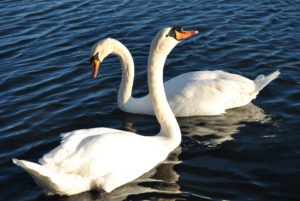
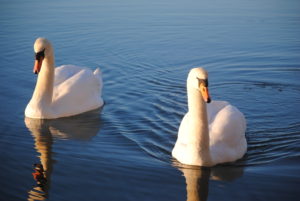
We begin with the 2 pairs. The males ( Cobs ) were large, aggressive and equally matched and they spent much of their time in battles, fights that neither could win. Both pairs bred successfully and produced cygnets who grew up and flew away. The battles for domination continued. In 2009 tragedy struck the west end pair when, whilst trying to defend her 3 month old cygnets, the female ( Pen ) was killed by a fox. Her mate looked after his young until it was time to chase them off and then he too left the lagoon.
Two weeks passed when he appeared again, with a new mate! ( Yes swans do pair up for life – but more accurately – til death do us part! )
An unexpected development decided the long war between the 2 males. Having failed to win the fight with the east end male, the returning west end male attacked his mate leaving her with injuries from which she sadly died. The East end male left – for good.
The west end male and his new mate became King and Queen of the Widewater and still reign supreme chasing off any intruding swans that dare to land here!
In 2012 the pair lost their west end nesting site at the bottom of a garden due to housing development so they took over the vacant nest site of the previous pair at the east end of the lagoon. A much better idea!
I’ve been trying to work out the age of the male but can’t be entirely sure. I think he must be about 20 years old having added together the age that they start breeding (about 4 years) with the breeding years that I’ve recorded and some before that. He is an old warrior showing some signs of arthritis now and more recently the female has started to take over as first defender of the lagoon. She seems to know that this is what she must do. But I have seen him find the warrior in him when his mate is challenged. He isn’t giving up his long fought for kingdom, after all, in a world of diminishing wildlife habitats, it’s prime territory.
Breeding record
Breeding history of the present pair
Cygnets hatched. Cygnets survived. ( Flying to the river Adur in the Spring )
2010 6 0 ( Predation )
2011 8 0 ( Salinity intolerance )
2012 5 5 100%
2013 6 6 100%
2014 2 1 (cygnet died at 2 weeks)
2015 7 7 100%
2016 5 5 100%
2017 4 4 100%
As you can see, this is a particularly successful breeding pair. In more wild habitats, a typical survival rate will be 2 cygnets ( 25-33% ). At Widewater, conditions are highly favourable.
WOW has erected fencing around the nest site to protect the swans and cygnets from foxes and dogs. Dogs off leads have been, and still are, a danger to the swans but WOW has worked with Lancing Parish Council to establish the nature reserve as a protected area. PSPOs – Public Space Protection Orders mean that offences can now lead to prosecution. Our aim is to raise awareness of the importance of putting dogs on leads here to protect the wildlife.
After breeding for 7 years, the Swan pair are very experienced parents ( note how when the new female began breeding in 2010/11 the survival rate was 0%.) and as such they are effective in protecting their young at the most vulnerable stage, the first 2 weeks, when they are at risk from predators such as Gulls and Crows.
Widewater has plenty of natural food – Swans are vegetarians and mainly feed on weed in the lagoon. A small amount of supplementary feeding by residents has helped to accelerate their growth past the point where they can taken by predators. More importantly, residents put out fresh water for the cygnets as they don’t develop the ability to excrete salt from the water until they are more mature. Widewater is a saline lagoon so this can be a problem for them at first.
Feeding the swans is not necessary but we appreciate that it can be an enjoyable, occasional experience – so if you do, give a small amount of whole wheat thrown into the water or a handful of salad leaves or grass cuttings. Never feed dry food out of the water.
Swan Watching. It is an endless joy to watch the parents nuture their cygnets and teach them to fly. Here are some dates to look out for:
March – Mating. The swans perform a beautiful mating ritual, quite often! Look out for this beginning with alternate head dipping over each other’s necks.
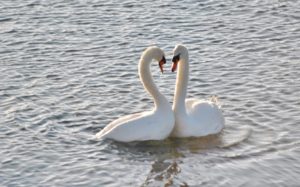
April – Nesting. The pair repair and build their nest ready for the female to lay her eggs. She will sit for about 35 days incubating them. The male will be seen patrolling the territory alone but spending much of his time near his mate.
May – Nearly always for this pair, the eggs hatch on the 1st/2nd May! The cygnets stay on the nest for a couple of days then they are taken on the water. Watch closely as you will see the female carry them on her back. You can see their heads peeping out from her wings!
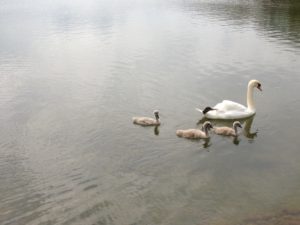
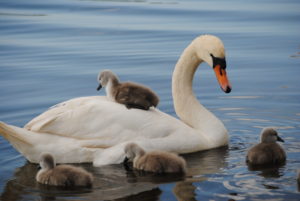
June/July – Flying lessons begin. The female paddles fast in the water and the cygnets paddle after her! This develops into running across the water and flapping their wings. Finally they take off flying low over the water. With time and practice they fly higher and higher. The female teaches them to fly as the male is in his annual moult where he has shed his primary flight feathers. The female went through her moult whilst on the nest. Nature has sorted it out so that one parent is always able to fly. Clever! The last stage is when the cygnets, now juvenile swans, are taken on flights away from the lagoon. Usually it is out to sea and back. As the juveniles get older they sometimes go on their own practice flights and may be away for a day or two.
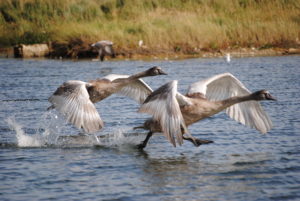
February – it’s nearly time for the juvenile swans – now with mainly white feathers – to leave the lagoon and join the flock of other young swans on the river Adur. The parents gradually become increasingly aggressive towards them biting and nipping them and finally chasing them away. It’s sad to see but they must go to make way for the next batch. The parents will be mating and nest building – the cycle begins again.
